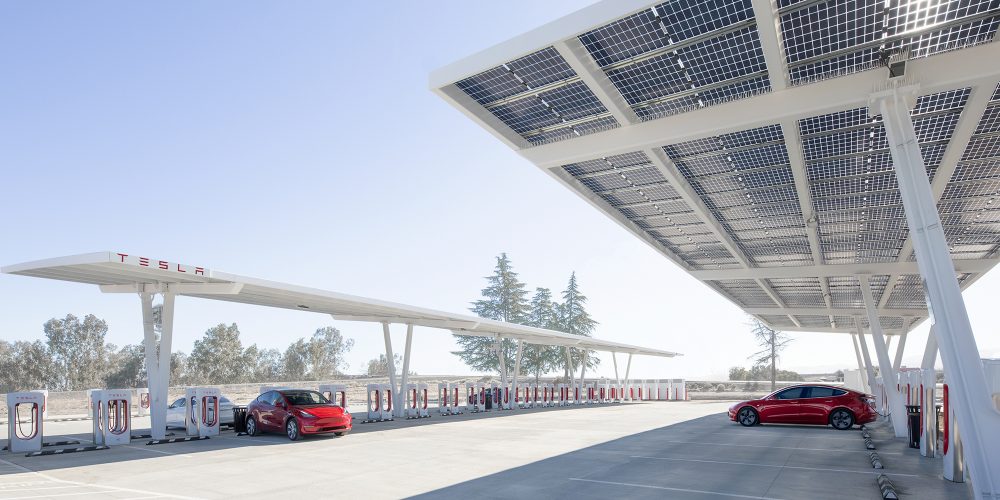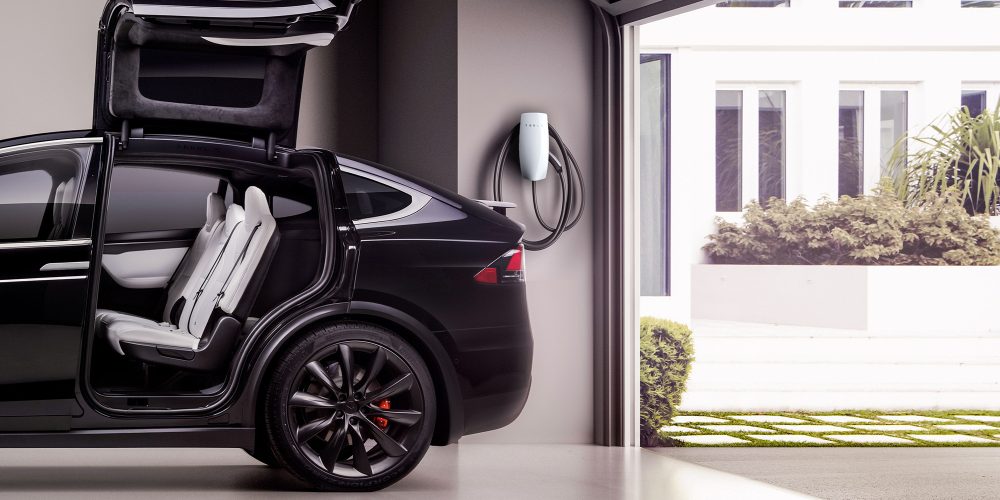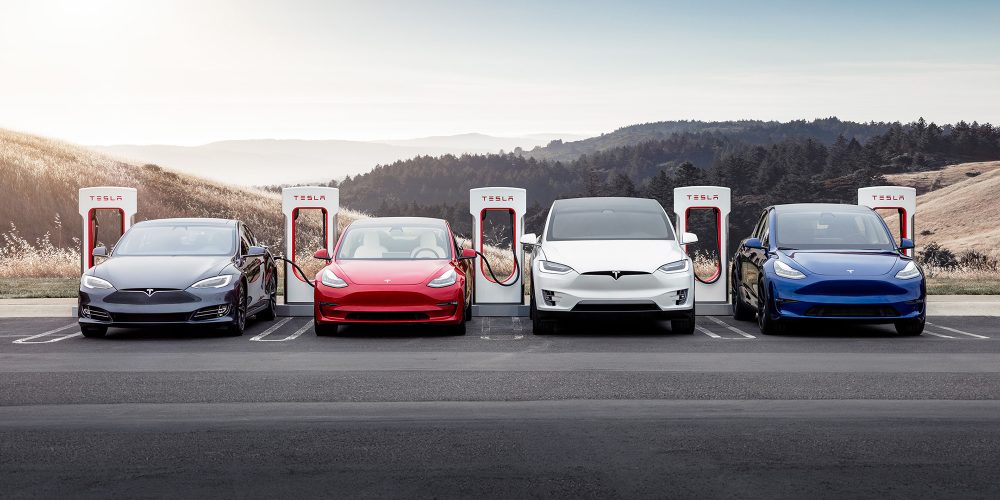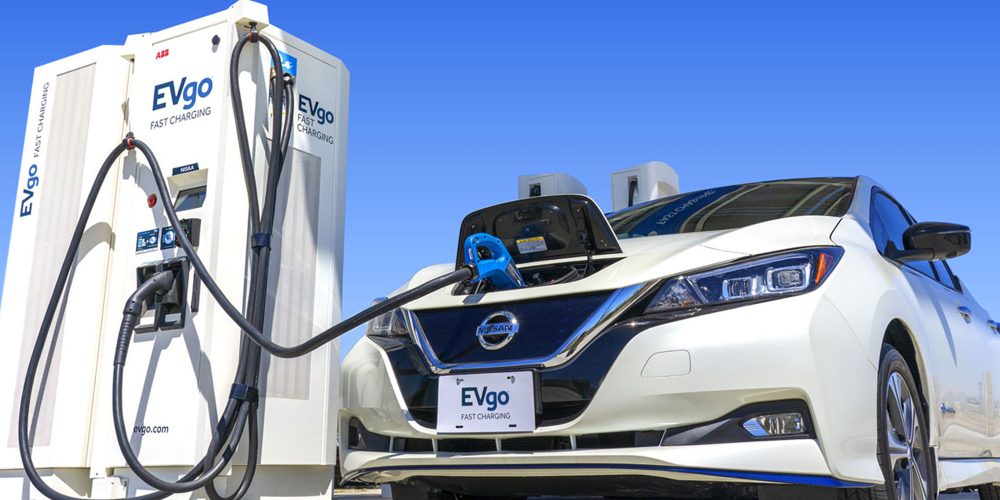
When thinking about a future electric vehicle purchase like a Tesla, your first thought might be, “how much does a Tesla cost?” Well, we’ve already covered that for you. If you’re like many people and are new to the world of electric vehicles, your next question might be, “how much does it cost to charge a Tesla?”
Excellent question, it costs $10. Just kidding, it’s unfortunately not that cut and dry. Below is a detailed breakdown of the factors that contribute to the cost of EV charging and easy ways to estimate how much you may pay to charge your next electric vehicle, regardless of make or model.
Table of contents
Introduction to EV charging
Before we dig right into the monetary differences in how much it costs to charge a Tesla, it’s important to understand the differences between charging levels. While each level offers different rates of charges based on a number of factors, these choices will also affect how little or much you pay while you charge back up.
Level 1 AC
Think of Level 1 as the universal charging option. If there is a standard wall socket nearby, you will be able to charge your Tesla without issue… or speed. Realistically, 110-120V is the bare minimum amount of juice you can pull into your EV. So if the battery capacity of your 2021 Tesla Long Range Model 3 is 82 kWh, you’re looking at days to charge, not hours.
AC Level 2
These chargers are the most common type found at third-party public stations. 220-240V plugs usually offer around 40 to 50 amps and are usually more strategically placed when in a home. This level of power is equivalent to your dryer or another large appliance.
Tesla encourages owners to install a Level 2 charger in their home if they can, which is usually a fairly easy process for an electrician or specialist to install. With Level 2, you can charge your Tesla in around 8-12 hours.
DC Fast Charger (Tesla Supercharger)
These Level 3 chargers abandon the alternating current (AC) methods above to mainline power directly from the grid. While they require a lot more power (480+ volts and 100+ amps), their output is tenfold greater.
Most Tesla Superchargers can now recharge up to 200 miles of range in only 15 minutes, depending on the charge rate. Superchargers also range from charging speeds of 90 kW to 250 kW, depending on what Supercharger station you end up at.
Due to their massive direct current (DC), Superchargers are not recommended for daily Tesla charging. Instead, Superchargers provide a quick charge for drivers on the go or for those making pit stops on longer road trips.
Looking for more info on Tesla’s Supercharger network? Perfect, we’ve already put together a comprehensive guide for you.

Other important factors to note
The prices below cover the approximate cost of charging your Tesla EV from 0 to 100 percent, even though you should never let your vehicle battery get to 0 percent. Furthermore, you generally shouldn’t charge your Tesla all the way to 100 percent unless you need that full range and plan to drive it soon after charging.
Also, remember that AC chargers are not perfectly efficient, and more kWh of energy is required to replenish a battery pack than the actual battery capacity itself.
This is because the vehicle has to convert the alternating current (AC) from the electrical circuit to a direct current (DC) that can be successfully used to charge the battery. As a result, the efficiency of the charger decreases, especially as your EV battery creeps closer to full capacity, since the level of heat increases, releasing precious energy.
Luckily, Tesla’s can use this heat for things like battery preconditioning in cold weather, but for the sake of strictly charging, you will require more kWh of energy to charge your battery than the actual battery size.
How much does it cost to charge a Tesla at home?
To begin, we will compare prices of each Tesla model based on the AC charging capabilities available to you at your abode. By using some relatively novel math (still somewhat difficult for a lowly tech writer), we can determine approximately what it may cost you to charge your Tessie on average in the US.
Then, you can use this math later to determine a more precise cost in your home state… if you want. The data used to approximate these costs was gathered from the US Energy Information Administration (EIA), which was last updated in April of 2021.
For the costs associated with charging from home, we used the US average costs for residential energy usage in cents per kiloWatt hour (kWh). This averages out to $0.138 per kWh, but we will round up to $0.14 to keep things neat.
Additionally, we are using the current and upcoming Tesla models listed on its website to figure the latest battery sizes and estimated range.
Tesla Model S
Both the upcoming Long Range and Plaid Model S will feature a 100 kWh battery pack, a nice clean number to do our math with. So for 100 kWh of energy, you’re looking at $14, but not so fast! Remember our paragraph above, AC chargers are not perfectly efficient, so we must account for that in our equation.
Average efficiency rates for Level 1 and Level 2 AC chargers fall between 80-90%, so we will call it right down the middle at 85% efficiency. So where were we? Ah yes, a 100 kWh battery on the Model S at $0.14 per kWh, plus the 15% additional energy required due to inefficiency… calculating… voilà!
It will cost you approximately $16.47 to fully charge your Model S from 0-100%, so realistically it should be less than that depending on your starting battery life.
Now, the Model S Long Range currently has an EPA estimated range of 405 miles, which means you’d be paying about $0.041 per mile or $4.07 for 100 miles of range.
The highly anticipated Model S Plaid has an estimated range of 390 miles, coming out to $0.042 per mile or $4.22 per 100 miles.
Tesla Model X
Like its older sedan sibling, both upcoming trims on the Model X feature a 100 kWh battery pack as well. Same battery size, same price – $16.47 to fully charge your Model X from 0-100%.
However, the Model X is a larger and heavier Tesla than the Model S and comes with a lower range, so let’s calculate cost per mile. First, the Model X Long Range, at an estimated range of 360 miles, will cost about $0.046 per mile and $4.58 for 100 miles of range.
For the speedier but lower range Model X Plaid, its 340-mile estimated range costs roughly $0.048 per mile and $4.48 per 100 miles.

Tesla Model 3
Let’s dig into the newer models next, beginning the cheapest Tesla to date, the Model 3. This Tesla gets a little more interesting because its trims vary in battery size. For instance, the Standard Range Plus Model 3 comes with a 50 kWh battery, while the Long Range and Performance versions sit upon an 82 kWh battery.
Let’s start with the smallest and go bigger. A 50 kWh battery on the Tesla Model 3 Standard Range Plus will cost approximately $8.24 to fully charge. Not too shabby.
With added battery comes added range, but with added range comes additional charging. With additional charging comes additional cost, so let’s calculate it for the Long Range and Performance trims. An 82 kWh battery will cost, on average in the US, $13.51 to go from 0-100%, accounting for an 85% charging efficiency.
Now, let’s talk mileage. The Long Range Model 3 offers an EPA estimated 353-mile range, which equates out to about $0.038 per mile and $3.83 every 100 miles. Performance trim on the Model 3 is not far behind at an EPA range of 315 miles, costing around $0.043 per mile or $4.39 per 100 miles.
Last but not least (unless we’re talking range) is the Standard Range Plus Model 3. Its 263-mile range will run you approximately $0.031 per mile and a very reasonable $3.13 for 100 miles of range.
Tesla Model Y
Until Cybertruck eventually delivers, the newest Tesla to hit roads in the US remains the Model Y. Currently available in two trims, both the Long Range and Performance versions feature a 75 kWh battery.
That means it will cost a Model Y owner in the US approximately $12.35 on average to fully charge their Tesla.
To break it down in terms of mileage, the Model Y Long Range and its EPA estimated 326-mile range will cost roughly $0.038 per mile or $3.79 per 100 miles of range.
Additionally, the 303 miles of EPA range on the Performance version of the Tesla Model Y comes out to about $0.041 per mile or, better yet, $4.08 per 100 miles.
Cost to charge a Tesla Supercharger/DCFC
Not only can DC Fast Chargers get you back on the road fully juiced a lot quicker, but they can just as easily prove to be a lot cheaper too.
Again, these prices all depend on the state you’re in, the rates during the time of charge, and how much energy you’re actually taking from the grid, but on average, commercial energy prices are cheaper in the US.
Like the residential numbers, we will again utilize data from the EIA for average commercial energy costs in the US. This comes out to $0.1099 per kWh, so we feel safe rounding up to a cool 11 cents.
DCFC’s like Tesla Superchargers snag DC power directly without having to convert it for your EVs battery, making them much more efficient compared to Level 1 and 2 charging. Charging efficiencies range from around 90% to 99%, so for our estimates, we will call it 95%.
Tesla Model Y
This time we will start with the youngest and go from there. You know the drill by now; the Model Y features a 75 kWh battery. Multiply that by the average commercial cost of $0.11 per kWh, account for 95% efficiency, and you’re looking at a price of $8.68 to charge your Tesla on a Supercharger or DCFC equivalent.
Breaking it down in terms of mileage, the Long Range Model Y costs approximately $0.027 per mile or $2.66 per 100 miles. On the other hand, a Performance Model Y will run you about $0.029 per mile and $2.87 for 100 miles of range.
Gas is averaging around $3.15 a gallon in the US right now, so those numbers have to sound pretty enticing.
Tesla Model 3
Moving on to the least expensive Tesla, the 50 kWh battery on the Standard Range Plus Model 3 will cost approximately $5.79 to fully charge, while the 82 kWh batteries on the other trims will run you about $9.49 each.
A Standard Range Plus Model 3 comes out to roughly $0.022 per mile and $2.20 for 100 miles of range. Meanwhile, the Performance Model 3 and its 315-mile range will cost about $0.030 per mile and around $3.01 for 100 miles.
Lastly, the 353 miles on the Long Range 3 equals out to approximately $0.027 per mile and about $2.69 per 100 miles.

Tesla Model X
Our last two Tesla models should go quickly as they both utilize a 100 kWh battery pack. That means in order to charge from 0-100%, accounting for 95% battery efficiency, it will cost approximately $11.58 to fully charge a Model X via DC Fast Charging.
Cost per mile is where things vary, however. The Long Range Model X comes is around $0.032 per mile and $3.22 per 100 miles, while the 340 available miles on the Plaid will cost roughly $0.034 per mile or $3.41 for 100 miles of range.
Tesla Model S
Both versions of the Model S also feature the 100 kWh battery (see above). That being said, let’s skip right through to the cost per mile.
The Long Range Model S comes out to $0.029 per mile and approximately $2.86 for 100 miles of range. With a lower estimated range, the Model S Plaid will cost you about $0.030 per mile and $2.97 per 100 miles.
Ways to save money charging your Tesla EV
The numbers above are simply estimates to give you an idea of the sorts of cost differentials between charging levels. Again, additional factors such as your location, your charger, and whether its peak energy usage time all can play a big role.
Either way, they should offer some idea of how to most effectively choose what style of charging is best for your given battery level situation. Additionally, there are other ways to save yourself some cash on public charging networks.
Does Tesla still offer free Supercharging?
Yes, but not recently. When Tesla EVs really began ramping up deliveries to customers after the debut of the Model S, many customers saw added perks like unlimited Supercharging. Over time, Tesla has incorporated similar promotions for specific models or customers who made a referral.
However, this still remains one of the most confusing potential perks for Tesla owners, old and new. We get a lot of questions, such as: How can I tell if my Tesla has free unlimited Supercharging?; Does free Supercharging transfer over?; and Does Tesla still offer free Supercharging?
We will have to get more granular on this in a separate post, but here are some broad strokes:
- Since mid-2020, Tesla has made no mention of additional free unlimited Supercharging
- Fully-transferable, free unlimited Supercharging has not been offered since 2017
- As the newest Tesla, the Model Y has never seen any free Supercharging promotions
- The best way to check if you or your Tesla have free unlimited Supercharging is to contact Tesla directly
Here’s a breakdown of what Tesla models may still have a promotion for free unlimited supercharging. Remember to check with Tesla to confirm if your EV qualifies or not:
*Note: No Tesla models from 2021 onward have any promotions for unlimited Supercharging at this time
| Tesla Model | Year(s) | Unlimited Supercharging status |
| Model Y | 2020-2021 | None |
| Model 3 | 2018-2019 | Performance trim only and must be original owner |
| Model X | 2016-2020 | Potentially available, confirm with Tesla |
| Model S | 2012-2020 | Potentially available (excluding the S 40), confirm with Tesla |
Third party charging networks offer occasional discounts
No matter what EV you drive, there are public charging options at your disposal from other networks aside from Tesla. Each has its own app, automaker partners, and deals for those who decide to charge with them.
These deals are always evolving and can apply to certain customers for purchasing a particular vehicle or can last a day or two for all customers during special events like a holiday. Do your research to see what charging networks have a footprint in your area and see what sort of promotions they may be offering.
Here are some places to start:
- Alternative Fuels Data Center (AFDC)
- AmpUp
- ChargeHub
- Chargemap
- ChargePoint
- Chargeway
- EVgo
- Greenlots
- Open Charge Map
- PlugShare

How to estimate the cost to charge any EV
So what if you don’t have a Tesla? Are you somehow unworthy knowing your cost to charge too? That couldn’t be further from the truth, my friends. No matter what zero-emission make or model you drive, you can still determine how much it will cost you to charge your electric vehicle?
Here’s a simple way to figure it out.
- Find your EV’s battery size (kWh)
- Note the EPA estimated range of your EV, or the average range your specific EV is currently getting you
- Visit the EIA website, and look up the average cost of residential electricity in your state, or in the US as a whole. Remember, these numbers are cents per kWh, so you’ll want to move that decimal place over to get to dollars (ex: 22.10 = $0.22)
- Multiply your cost per kWh x the size of your battery (ex: 0.22 x 75 kWh = $16.50 to fully charge)
- REMEMBER: We also need to account for charging efficiency (~85% for home and ~95% DCFC)
- Ex: $16.50 / 85 = 0.0194 x 15 = $2.91 (additional cost from energy lost during charging)
- Lastly, add for your total: $16.50 + $2.91 = $19.41 to fully charge your 75 kWh battery from 0-100%
Now that we have that, we can calculate costs in terms of miles:
- Take your total cost to charge, and divide it by your EV’s range, for an example we will say 305 miles
- $19.41 / 305 = $0.064 per mile (rounded)
- Now multiply that by 100 to get your cost per 100 miles: 0.064 x 100 = $6.36 for 100 miles of range
Subscribe to Electrek on YouTube for exclusive videos and subscribe to the podcast.
Author: Scooter Doll
Source: Electrek




